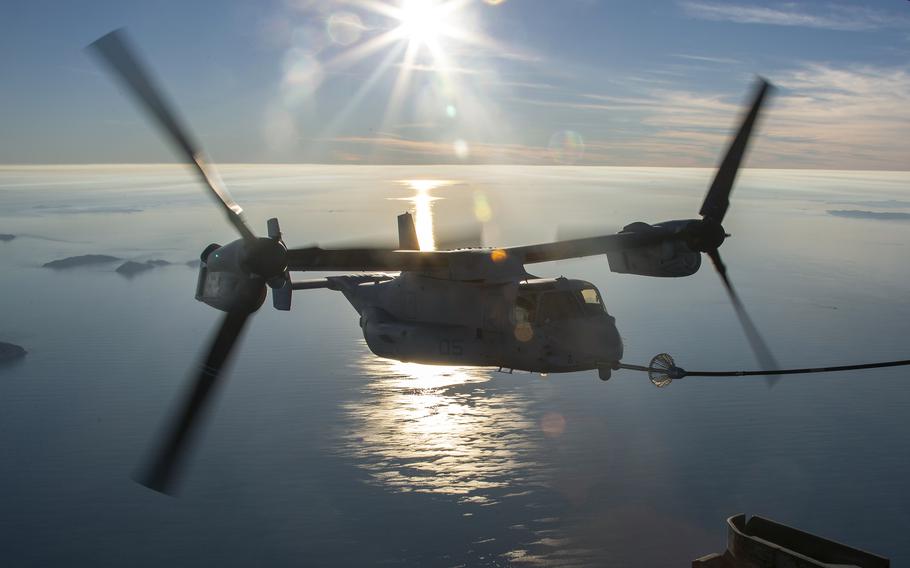
An MV-22 Osprey with Marine Medium Tiltrotor Squadron 265 refuels over Australia during the Talisman Sabre exercise in July 2019. (Jackson Ricker/U.S. Marine Corps)
CAMP FOSTER, Okinawa — An officer killed when an MV-22B Osprey crashed last year over northern Australia also piloted the tiltrotor that went down off Okinawa in 2016, according to the Marine Corps.
Maj. Tobin Lewis, 37, of Jefferson, Colo., was one of two pilots flying the Osprey that crashed Aug. 27, 2023, with 23 aboard on Melville Island, north of Darwin in Australia’s Northern Territory.
Lewis, the squadron executive officer and Osprey command pilot, died alongside two other Marines, pilot Capt. Eleanor LeBeau, 29, and crew chief Cpl. Spencer Collart, 21.
Their aircraft was assigned to Marine Medium Tiltrotor Squadron 363 at Kaneohe Bay, Hawaii.
A Marine Corps accident report released Aug. 9 identified “pilot error and complacency” as the primary cause of the fatal crash. The Osprey went down after a close call with another aircraft during their approach to a landing zone, according to the report. It also found that squadron leadership had permitted “a culture that disregarded safety of flight.”
Lewis also was the commander and pilot of an Osprey that crashed offshore of Camp Schwab, injuring two crewmembers, on Dec. 13, 2016, according to the report and the III Marine Expeditionary Force.
He was not identified publicly by the Marine Corps as the pilot in the Okinawa incident prior to the Aug. 9 report being released.
“Pilot error due to a loss of situational awareness” and not mechanical failure was the primary cause of the Okinawa accident, III MEF spokesman 1st Lt. Owen Hitchcock wrote in an email to Stars and Stripes on Tuesday.
Lewis, a captain at the time, and four other Marines were on board during a nighttime training mission when the Osprey’s propeller cut a refueling hose on an Air Force C-130 tanker. Rather than risk crashing the Osprey into a residential area near Marine Corps Air Station Futenma, Lewis flew the aircraft about 18 miles north and set it down offshore.
That Osprey was assigned to Marine Medium Tiltrotor Squadron 265 with Marine Aircraft Group 36, 1st Marine Aircraft Wing, according to the report.
Lewis’ Field Flight Performance Board held Dec. 20, 2016, and included in the Australia accident report, found that he made “excessive changes in power” to the aircraft during aerial refueling. That and “insufficient” safety briefs before the flight contributed to the Okinawa accident, the report states.
Lewis and another pilot made multiple failed attempts to refuel the Osprey during the northbound leg of the flight, according to the board’s report.
On the second-to-last attempt to connect with the C-130, the drogue, or fuel funnel, came close to hitting the Osprey’s nose, and Lewis failed to tell the rest of the crew, the report states. Lewis then dropped back behind the C-130 for one more attempt, which “resulted in the impact of the right proprotor to the left refueling drogue” of the tanker.
The board unanimously recommended Lewis be placed on conditional flight status beginning in February 2017 and receive remedial training. Lewis “completed a comprehensive review of the MV-22 syllabus under the supervision of an experienced pilot,” Hitchcock said. He returned to full flight duties in 2019.
U.S. officials told the government of Japan in September 2019 that Lewis had been disciplined, the Mainichi newspaper reported at the time.
Lewis was born and raised in Conifer, Colo., according to the ABC affiliate in Denver. He was commissioned in August 2008 and promoted to major in October 2018. He served in Pensacola, Fla.; Corpus Christi, Texas; Jacksonville, N.C.; Okinawa; and Kaneohe Bay, Hawaii.
He logged 1,800 flight hours, including 1,500 in Ospreys, according to his obituary from Evergreen Memorial Park in Colorado. His awards include two Navy and Marine Corps Commendation Medals, the Navy and Marine Corps Achievement Medal, Navy Unit Commendation, National Defense Service Medal, Global War on Terrorism Expeditionary Medal, Global War on Terrorism Service Medal, and four Sea Service Deployment Ribbons.
Stars and Stripes reporter Keishi Koja contributed to this report.